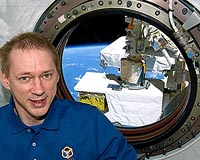 |
Houston TX (SPX) Dec 03, 2009 Using more advanced analytical instruments now available, a Johnson Space Center research team has reexamined the 1996 finding that a meteorite contains strong evidence that life may have existed on ancient Mars. The new research focused on investigating alternate proposals for the creation of materials thought to be signs of ancient life found in the meteorite. The new study argues that ancient life remains the most plausible explanation for the materials and structures found in the meteorite. In 1996, a group of scientists led by David McKay, Everett Gibson and Kathie Thomas-Keprta of NASA's Johnson Space Center (JSC) in Houston published an article in Science announcing the discovery of biogenic evidence in the ALH84001 meteorite. A newly published paper revisits that original hypothesis with new analyses. The paper, "Origin of Magnetite Nanocrystals in Martian Meteorite ALH84001," by Thomas-Keprta and coauthors Simon Clemett, McKay, Gibson and Susan Wentworth, all scientists in the Astromaterials Research and Exploration Science Directorate at JSC, is in the November issue of the journal Geochimica et Cosmochimica Acta of The Geochemical Society and The Meteoritical Society. Magnetite crystals in ALH84001 have been a focus of debate about the possibility of life on Mars. Magnetite is an iron-bearing, magnetic mineral. On Earth, some water and soil bacteria secrete the mineral within their cells. The 1996 study suggested that some magnetite crystals associated with carbonate globules in ALH84001 are biogenic because they share many characteristics with those found in bacteria on Earth. Other scientists have argued instead that the magnetite in ALH84001 was likely caused by inorganic processes, and that those same processes can be recreated artificially in the laboratory by heating carbonates in a process known as thermal decomposition, forming magnetite identical to that found in the Mars meteorite. In this new study, the JSC research team reassessed the leading alternative non-biologic hypothesis that heating or shock decomposition produced the magnetites. The authors argue that their new results do not support the heating hypothesis for the formation of the magnetites. They conclude that the biogenic explanation is a more viable hypothesis for the origin of the magnetites. "In this study, we interpret our results to suggest that the in situ inorganic hypotheses are inconsistent with the data, and thus infer that the biogenic hypothesis is still a viable explanation," said lead author Thomas-Keprta, senior scientist for Barrios Technology at JSC. "We believe that the biogenic hypothesis is stronger now than when we first proposed it 13 years ago," said Gibson, NASA senior scientist. In addition to the new paper on ALH84001, the JSC team has published a paper that identifies shapes or morphologies in Martian meteorites that resemble known microfossil and microbial shapes in samples from Earth. These new shapes, seen with a scanning electron microscope, are termed biomorphs because of their close resemblance to known, biologically produced features on Earth. The biomorphs observed in the meteorites will be the focus of the JSC team with more detailed studies, including chemical and isotopic analyses. "The evidence supporting the possibility of past life on Mars has been slowly building up during the past decade," said McKay, NASA chief scientist for exploration and astrobiology, JSC. "This evidence includes signs of past surface water including remains of rivers, lakes and possibly oceans, signs of current water near or at the surface, water-derived deposits of clay minerals and carbonates in old terrain, and the recent release of methane into the Martian atmosphere, a finding that may have several explanations, including the presence of microbial life, the main source of methane on Earth." Share This Article With Planet Earth
Related Links View the two papers, imagery and associated materials Mars News and Information at MarsDaily.com Lunar Dreams and more
 ESA Astronaut Frank De Winne Safely Back On Earth
ESA Astronaut Frank De Winne Safely Back On EarthParis, France (ESA) Dec 02, 2009 The Soyuz TMA-15 reentry module landed safely in Kazakhstan at 13.15 local time (08.15 CET), bringing ESA astronaut Frank De Winne, Russian cosmonaut Roman Romanenko and Canadian Space Agency astronaut Robert Thirsk back to Earth. The landing concluded the six-month OasISS mission, ESA's second long-duration mission to the International Space Station (ISS). This flight saw Frank De Winne ... read more |
|
| The content herein, unless otherwise known to be public domain, are Copyright 1995-2009 - SpaceDaily. AFP and UPI Wire Stories are copyright Agence France-Presse and United Press International. ESA Portal Reports are copyright European Space Agency. All NASA sourced material is public domain. Additional copyrights may apply in whole or part to other bona fide parties. Advertising does not imply endorsement,agreement or approval of any opinions, statements or information provided by SpaceDaily on any Web page published or hosted by SpaceDaily. Privacy Statement |